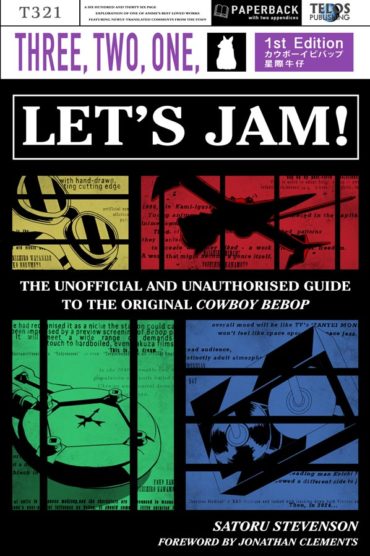Three, Two, One, Let’s Jam: The Unofficial and Unauthorised Guide to the Original Cowboy Bebop Review
Three, Two, One, Let’s Jam (ignoring the subtitle for the sake of my wrists) is the latest book from Telos Publishing, a small UK company specialising in more culty and pulpy unofficial books that have oddly never stepped into the world of anime until now. Written by Satoru Stevenson, the book goes into extreme detail on not just the behind-the-scenes making of the show but on each individual episode, the film, even the PlayStation games and more, and the emphasis should really be on extreme here. Not content with just giving the author’s thoughts, the book contains countless newly unearthed and translated quotes from those who made the show, both contemporary and retrospectively, as well as the network execs and others involved in the process.
This was definitely the highlight of the book for me, hearing how the show was pitched, rejected by the censors, reworked and generally how it was such a gentle ripple at the time with no one outside of the core creative bubble thinking it would be anything special, then reading as it gained such momentum as it aired. It keeps going too, as each episode (or “session”) comes packed with not just a deep-dive analysis of the material but notes on the planning, writing and animation of each story with more newly revealed quotes and facts thrown, in plus character bios for any character with even a slight impact on the story. Some of the more meaty episodes reach into the double digits in page count as Satoru unearths more facts, checks for more references and musical cues, and generally puts every second of footage under the microscope. It’s an impressive display of dedication and clear love for the source material. Even the opening and endings are broken down for references and significance shot-by-shot.
Then you reach the end of the series and soon you get another extensive behind-the-scenes look at how the movie, Knocking on Heaven’s Door, came about, its scripting, pitching and eventual release before a similarly lengthy look at the film itself. As the page count sneaks past 500, we start looking at the supplementary media: short TV specials, live action mini-sodes and the aforementioned PS1 and PS2 games, all getting plenty of analyses, behind-the-scenes info, facts and character bios. As someone who has written a lot of reviews over the last ten years, I’m pretty sure my entire backlog wouldn’t fill a book this size, so to see this level of detail on one franchise that at the end of the day is really just 26 episodes and one film is crazy, in a great way.
Cowboy Bebop wouldn’t be where it is as well if it weren’t for it, and its creator’s, heavy love of music, not just its classic catchy opening and great OST but all the little connections and references, and once again Satoru Stevenson has that covered too, including a full-on music index and more. Plus it has a check list of every media release the show and film has received in the US, UK and Australia, for those wishing to collect every English release of the show.
In summary, should you pick up Three, Two, One, Let’s Jam? If you have a deep love for the show then this book will be hard to put down, but given its length, both page count and sheer amount of often heavily-wordy text, and the fact that being an “unofficial and unauthorised” release means it has no artwork what-so-ever across the roughly 600 pages (not including the large appendix), if you only have a passing interest or none at all then that’s a lot of black and white text to grind through. For fans though, it’s a must-buy. I thought I knew a lot about the series and its creative team but I was constantly finding out new information, which kept me going from page to page, session to session until the end.
Our review copy was supplied by Telos Publishing.


